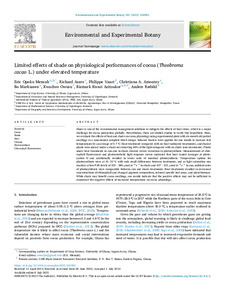| dc.contributor.author | Mensah, E.O. |
| dc.contributor.author | Asare, R. |
| dc.contributor.author | Vaast, P. |
| dc.contributor.author | Amoatey, C. |
| dc.contributor.author | Markussen, B.O. |
| dc.contributor.author | Owusu, K. |
| dc.contributor.author | Asitoakor, B.K. |
| dc.contributor.author | Raebild, A. |
| dc.date.accessioned | 2022-08-10T11:17:57Z |
| dc.date.available | 2022-08-10T11:17:57Z |
| dc.date.issued | 2022 |
| dc.identifier.citation | Mensah, E.O., Asare, R., Vaast, P., Amoatey, C., Markussen, B.O., Owusu, K., ... & Ræbild, A. (2022). Limited effects of shade on physiological performances of cocoa (Theobroma cacao L.) under elevated temperature. Environmental and Experimental Botany: 201: 104983, 1-11. |
| dc.identifier.issn | 0098-8472 |
| dc.identifier.uri | https://hdl.handle.net/20.500.12478/7628 |
| dc.description.abstract | Shade is one of the recommended management solutions to mitigate the effects of heat stress, which is a major challenge for cocoa production globally. Nevertheless, there are limited studies to verify this hypothesis. Here, we evaluate the effects of heat and shade on cocoa physiology using experimental plots with six-month old potted seedlings in a randomized complete block design. Infrared heaters were applied for one month to increase leaf temperatures by an average of 5–7 ºC (heat treatment) compared with no heat (unheated treatments), and shaded plants were placed under a shade net removing 60% of the light compared with no shade (sun treatments). Plants under heat treatments in sun and in shade showed severe reduction in photosynthesis. Measurements of chlorophyll fluorescence and photosynthetic light response curves indicated that heat caused damages at photosystem II and additionally resulted in lower rates of maximal photosynthesis. Temperature optima for photosynthesis were at 31–33 ºC with only small differences between treatments, and as light saturation was reached at low PAR levels of 325 – 380 µmol m−2 s−1 in shade and 427 – 521 µmol m−2 s−1 in sun, ambient rates of photosynthesis were comparable between sun and shade treatments. Heat treatments resulted in decreased concentrations of chlorophyll and changed pigment composition, reduced specific leaf areas, and plant biomass. While shade may benefit cocoa seedlings, our results indicate that the positive effects may not be sufficient to counteract the negative effects of increased temperatures on cocoa physiology. |
| dc.description.sponsorship | Ministry of Foreign Affairs of Denmark |
| dc.format.extent | 1-11 |
| dc.language.iso | en |
| dc.subject | Cocoa |
| dc.subject | Theobroma Cacao |
| dc.subject | Climate |
| dc.subject | Photosynthesis |
| dc.title | Limited effects of shade on physiological performances of cocoa (Theobroma cacao L.) under elevated temperature |
| dc.type | Journal Article |
| cg.contributor.affiliation | University of Ghana |
| cg.contributor.affiliation | University of Copenhagen |
| cg.contributor.affiliation | International Institute of Tropical Agriculture |
| cg.contributor.affiliation | Université de Montpellier |
| cg.coverage.region | Africa |
| cg.coverage.region | West Africa |
| cg.coverage.country | Ghana |
| cg.coverage.hub | Headquarters and Western Africa Hub |
| cg.researchtheme | Natural Resource Management |
| cg.identifier.bibtexciteid | MENSAH:2022 |
| cg.isijournal | ISI Journal |
| cg.authorship.types | CGIAR and developing country institute |
| cg.iitasubject | Agronomy |
| cg.iitasubject | Cocoa |
| cg.iitasubject | Plant Health |
| cg.journal | Environmental and Experimental Botany |
| cg.notes | Open Access Article; Published online: 08 Jul 2022 |
| cg.accessibilitystatus | Open Access |
| cg.reviewstatus | Peer Review |
| cg.usagerightslicense | Creative Commons Attribution 4.0 (CC BY 0.0) |
| cg.targetaudience | Scientists |
| cg.identifier.doi | https://dx.doi.org/10.1016/j.envexpbot.2022.104983 |
| cg.iitaauthor.identifier | Richard Asare: 0000-0001-6798-7821 |
| cg.futureupdate.required | No |
| cg.identifier.issue | 104983 |
| cg.identifier.volume | 201 |

